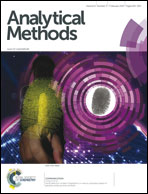Ultrasound-vortex-assisted dispersive liquid–liquid microextraction coupled with gas chromatography with a nitrogen–phosphorus detector for simultaneous and rapid determination of organophosphorus pesticides and triazines in wine†
Abstract
A low solvent consumption method for the sensitive determination of organophosphorus (OP) and triazine (TR) pesticides in wine samples is studied. The pesticides were extracted by ultrasound vortex assisted dispersive liquid–liquid microextraction (USVADLLME): 10 mL of sample, 1 mL of NaH2PO4 1 M, 10 μL tolidin in ethanol (internal standard) and 250 μL of C2H4Cl2 (extraction solvent) were vortexed for 30 s (any dispersive solvent was used) and the solution was kept in an ultrasound bath: the extraction was performed at 40 kHz of ultrasound frequency and 110 W for 10 min at room temperature. The determination was performed by means of gas chromatography equipped with nitrogen–phosphorus detector (GC-NPD). The enrichment factors of the analytes ranged from 210 to 232 fold and the recovery ranged from 92.0% to 103.4% (with a Relative Standard Deviation, RSD, below 7.5%). After centrifugation, the bottom phase of the chlorinated solvent was separated from the liquid hydro-alcoholic matrix, dried with anhydrous Na2SO4 and injected into the GC-NPD system. The efficiency of the liquid-phase micro-extraction process was slightly affected by the characteristics of wine samples, therefore the analytical characteristics of the method were evaluated in the linear range 0.01–10 ng mL−1. The correlation coefficients (R2) of each pesticide are above 0.963. The Limits of Detection (LOD) in GC-NPD vary between 0.007 ng mL−1 and 0.07 ng mL−1 (RSD ≤ 9.0) whereas the Limits of Quantification (LOQ) range between 0.024 ng mL−1 and 0.225 ng mL−1 (RSD ≤ 6.9); the intra-day and inter-day repeatabilities, calculated as RSD in the real matrix, are below 6.7% and 8.8%, respectively. Particular attention was devoted to comparing this methodology with other similar analytical methodologies: LODs and RSDs were studied and commented upon. It should be underlined that the good sensibility and high versatility of this methodology allow investigation of organophosphorus and triazine pesticides. At the end, the applicability of the method was demonstrated using commercial wine samples.


 Please wait while we load your content...
Please wait while we load your content...